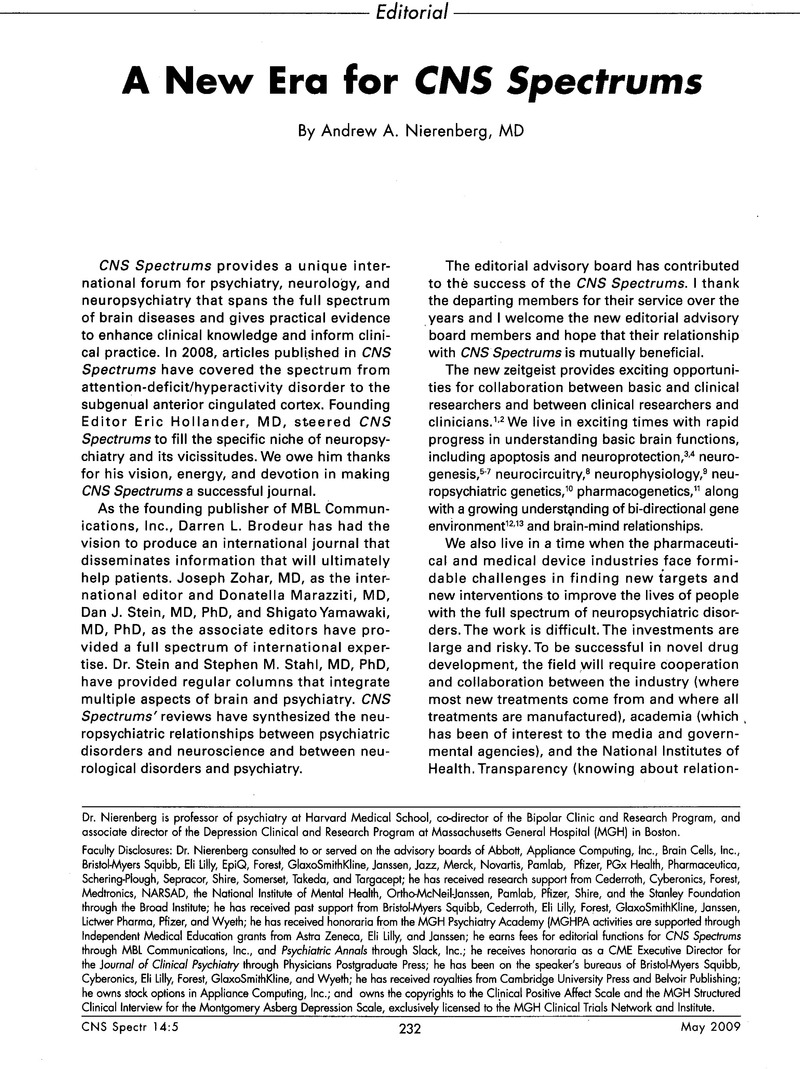No CrossRef data available.
Article contents
A New Era for CNS Spectrums
Published online by Cambridge University Press: 07 November 2014
Abstract
An abstract is not available for this content so a preview has been provided. As you have access to this content, a full PDF is available via the ‘Save PDF’ action button.

- Type
- Editor's Letter
- Information
- Copyright
- Copyright © Cambridge University Press 2009
References
REFERENCES
1.Insel, TR. Disruptive insights in psychiatry: transforming a clinical discipline. J Clin Invest. 2009;119:700–705.Google Scholar
2.Insel, TR. Translating scientific opportunity into public health impact: a strategic plan for research on mental illness. Arch Gen Psychiatry. 2009;66:128–133.Google Scholar
3.Gould, TD, Chen, G, Manji, HK. Mood stabilizer psychopharmacology. Clin Neurosci Res. 2002;2:193–212.Google Scholar
4.Marx, CE, Yuan, PX, Kilts, JD, Madison, RD, Shampine, LJ, Manji, HK. Neuroactive steroids, mood stabilizers, and neuroplasticity: alterations following lithium and changes in Bcl-2 knockout mice. Int J Neuropsychopharmacol. 2008;11:547–552.Google Scholar
5.Eriksson, PS, Perfilieva, E, Bjork-Eriksson, T, et, al, Neurogenesis in the adult human hippocampus. Nat Med. 1998;4:1313–1317.Google Scholar
6.Zhao, CM, Deng, W, Gage, FH. Mechanisms and functional implications of adult neurogenesis. Cell. 2008;132:645–660.Google Scholar
7.Sahay, A, Hen, R. Adult hippocampal neurogenesis in depression. Nat Neurosci. 2007;10:1110–1115.Google Scholar
8.Pezawas, L, Meyer-Lindenberg, A, Drabant, EM, et al.5-HTTLPR polymorphism impacts human cingulate-amygdala interactions: a genetic susceptibility mechanism for depression. Nat Neurosci. 2005;8:828–834.Google Scholar
9.Quiroz, JA, Gray, NA, Kato, T, Manji, HK. Mitochondrially mediated plasticity in the pathophysiology and treatment of bipolar disorder. Neuropsychopharmacology. 2008;33:2551–2565.Google Scholar
11.Lin, EG, Chen, PS. Pharmacogenomics with antidepressants in the STAR*D study. Pharmacogenomics. 2008;9:935–946.Google Scholar
12.Caspi, A, Sugden, K, Moffitt, TE, et al.Influence of life stress on depression: moderation by a polymorphism in the 5-HTT gene. Science. 2003;301:386–389.Google Scholar
13.Kendler, KS, Baker, JH. Genetic influences on measures of the environment: a systematic review. Psychol Med. 2007;37:615–626.Google Scholar
15.Angell, M. Drug Companies & Doctors: A Story of Corruption [New York Review of Books Web site]. January 15, 2009. Available at: http://www.nybooks.com/articles/22237. Accessed January 15, 2009.Google Scholar
16.Duvall, DG. Conflict of interest or ideological divide: the need for ongoing collaboration between physicians and industry. Curr Med Res Opin. 2006;22:1807–1812.Google Scholar
17.Stossel, TP. Regulating academic-industrial research relationships—solving problems or stifling progress? N Engl J Med. 2005;353:1060–1065.Google Scholar
18.Stossel, TP, Lee, K. Has the hunt for conflicts of interest gone too far? BMJ. 2008;336:476–477.Google Scholar
19.Nierenberg, AA. A counter proposal to manage financial conflicts of interest in academic psychiatry. World Psychiatry. 2007;6:34–36.Google Scholar


